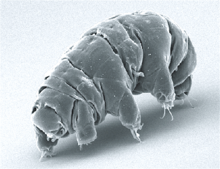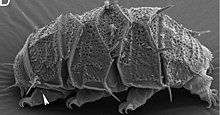Tardigrade
Tardigrades ('water bears') are microscopic, segmented animals.[1] They live in water. They are members of the tactopod phylum Tardigrada, part of the superphylum Ecdysozoa. They are also known as water bears or moss piglets.[2][3]
| Tardigrades Temporal range:
| |
|---|---|

| |
| Milnesium tardigradum, a eutardigrade | |

| |
| Echiniscus succineus, a heterotardigrade | |
| Scientific classification | |
| Domain: | Eukaryota |
| Kingdom: | Animalia |
| Subkingdom: | Eumetazoa |
| Clade: | ParaHoxozoa |
| Clade: | Bilateria |
| Clade: | Nephrozoa |
| (unranked): | Protostomia |
| Superphylum: | Ecdysozoa |
| (unranked): | Panarthropoda |
| Phylum: | Tardigrada Spallanzani, 1777 |
| Classes | |
| |
Tardigrades were first described in 1773.[4] While originally named Kleiner Wasserbär (little waterbear) by zoologist Johann August Ephraim Goeze, the name "Tardigrade" was later given in 1777, by biologist Lazzaro Spallanzani, with the name meaning "slow stepper".[5] There are more than 1000 different species of Tardigrade.[6]
Tardigrades have a cylindrical shape with four segments, each with two legs. Each leg has little claws.[6] The biggest adults may reach a body length of 1.2 mm, the smallest below 0.1 mm. Freshly hatched larvae may be smaller than 0.05 mm.[4] Tardigrades feed on plant cells by penetrating the cell wall and eating what is inside. Some tardigrades are carnivores.[7][6]
Tardigrades are eutelic: all adult Tardigrades of the same species have the same number of cells. Some species have as many as 40,000 cells in each adult, while others have far fewer.[8][5]
Tardigrades can be found in many habitats: in moss,[7] freshwater,[7] the Himalayas,[4] and the ocean.[4] They are one of the few animals that can be found on the highest mountains and the deepest seas.[4] About 83% of the known species live on land, the other 17% live in water.[6]
Survivability
changeTardigrades are able to live in environments that would kill most animals.[1]
In 2007, scientists discovered that some Tardigrades were able to survive 10 days in outer space.[9][10] This meant living in a vacuum with severe radiation.[11][12][13]
Tardigrades can survive more than ten years without water.[14] Tardigrades can survive extreme temperatures. They can live for a few hours in temperatures close to absolute zero[7] and above boiling point.[14] They can survive a few minutes in temperatures as high as 151 °C (304 °F).[15][16] Some Tardigrades can survive being frozen for over 30 years.[17]
Tardigrades can also survive radiation at hundreds of times a level that would be deadly to humans.[18][19] They can also survive in toxic environments[20] and during impact events.[21]
In 2019, a lander with Tardigrades on board crashed on the moon. It is believed that the Tardigrades survived and could live for a few years on the moon.[22][23]
The Tardigrades slow their metabolism to survive these environments.[24] Rotifers have a similar agility to survive.
References
change- ↑ 1.0 1.1 Neuman, Yair (October 2006). "Cryptobiosis: A new theoretical perspective". Progress in Biophysics and Molecular Biology. 92 (2). Elsevier: 258–267. doi:10.1016/j.pbiomolbio.2005.11.001. PMID 16380155.
- ↑ Miller, William (2017-02-06). "Tardigrades". American Scientist. Archived from the original on 2018-04-14. Retrieved 2018-04-13.
- ↑ Simon, Matt (21 March 2014). "Absurd Creature of the Week: the incredible Ccritter that's tough enough to survive in the vacuum of space". Wired. Archived from the original on 2014-03-25. Retrieved 2014-03-21.
- ↑ 4.0 4.1 4.2 4.3 4.4 Riffenburgh, Beau (2007). Encyclopedia of the Antarctic. Vol. 1 (illustrated ed.). CRC Press. p. 983. ISBN 978-0-415-97024-2.
- ↑ 5.0 5.1 Bordenstein, Sarah. "Tardigrades (Water Bears)". Microbial Life Educational Resources. National Science Digital Library. Retrieved 2014-01-24.
- ↑ 6.0 6.1 6.2 6.3 Margulis, Lynn; Schwartz, Karlene V. (1998). Five kingdoms: an illustrated guide to the phyla of life on earth (illustrated ed.). Elsevier. p. 324. ISBN 978-0-7167-3027-9.
- ↑ 7.0 7.1 7.2 7.3 "Tardigrade (animal)". Encyclopædia Britannica. Archived from the original on 2011-01-23. Retrieved 2011-01-02.
- ↑ Seki, Kunihiro; Toyoshima, Masato 1998. Preserving tardigrades under pressure. Nature 395 (6705): 853–854. Preserving tardigrades under pressure | Nature Archived 2021-02-14 at the Wayback Machine
- ↑ Jönsso, K. Ingema; et al. (2008). "Tardigrades survive exposure to space in low Earth orbit". Current Biology. 18 (17): R729–R731. Bibcode:2008CBio...18.R729J. doi:10.1016/j.cub.2008.06.048. PMID 18786368. S2CID 8566993. Archived from the original on 9 April 2011. Retrieved 1 January 2011.
- ↑ Whalen, Joann K.; Sampedro, Luis (2010). Soil Ecology and Management (illustrated ed.). CABI. p. 73. ISBN 978-1-84593-563-4.
- ↑ "Creature survives naked in space". Space.com. 8 September 2008. Archived from the original on 2018-10-11. Retrieved 2011-12-22.
- ↑ Jönsson, K. Ingemar; Rabbow, Elke; Schill, Ralph O; Harms-Ringdahl, Mats; Rettberg, Petra (2008). "Tardigrades survive exposure to space in low Earth orbit". Current Biology. 18 (17): R729–R731. Bibcode:2008CBio...18.R729J. doi:10.1016/j.cub.2008.06.048. PMID 18786368. S2CID 8566993.
- ↑ Courtland, Rachel (8 September 2008). "'Water bears' are first animal to survive space vacuum". New Scientist. Archived from the original on 2011-05-11. Retrieved 2011-05-22.
- ↑ 14.0 14.1 Grimaldi, David; Engel, Michael S. (2005). Michael S. Engel (ed.). Evolution of the insects. Cambridge Evolution Series (illustrated, reprint ed.). Cambridge University Press. p. 97. ISBN 978-0-521-82149-0.
- ↑ Horikawa, Daiki D (2012). "Survival of Tardigrades in Extreme Environments: A Model Animal for Astrobiology". In Altenbach, Alexander V.; Bernhard, Joan M.; Seckbach, Joseph (eds.). Anoxia. Cellular Origin: life in extreme habitats and astrobiology. Vol. 21. pp. 205–17. doi:10.1007/978-94-007-1896-8_12. ISBN 978-94-007-1895-1.
- ↑ "Extreme animals - Astrobiology Magazine". Astrobiology Magazine. 2002-09-01. Archived from the original on 2017-05-31. Retrieved 2018-02-12.
- ↑ BBC News: News from elewhere. Japan: 'Water bear' reproduces after 30 years on ice - BBC News Archived 2021-02-23 at the Wayback Machine
- ↑ "Radiation tolerance in the tardigrade Milnesium tardigradum" (PDF).[permanent dead link]
- ↑ Horikawa, Daiki D.; Sakashita, Tetsuya; Katagiri, Chihiro; Watanabe, Masahiko; Kikawada, Takahiro; Nakahara, Yuichi; Hamada, Nobuyuki; Wada, Seiichi; Funayama, Tomoo (2006-01-01). "Radiation tolerance in the tardigrade Milnesium tardigradum". International Journal of Radiation Biology. 82 (12): 843–848. doi:10.1080/09553000600972956. ISSN 0955-3002. PMID 17178624. S2CID 25354328. Archived from the original on 2021-10-31. Retrieved 2021-10-31.
- ↑ Jönsson, K. Ingemar; Bertolani, Roberto (2001). "Facts and fiction about long-term survival in tardigrades". Journal of Zoology. 255 (1): 121–3. doi:10.1017/S0952836901001169. Archived from the original on 2021-10-31. Retrieved 2021-10-31.
- ↑ Sloan, David; Alves Batista, Rafael; Loeb, Abraham (2017). "The Resilience of Life to Astrophysical Events". Scientific Reports. 7 (1): 5419. arXiv:1707.04253. Bibcode:2017NatSR...7.5419S. doi:10.1038/s41598-017-05796-x. PMC 5511186. PMID 28710420.
- ↑ Sample, Ian (6 August 2019). "Tardigrades may have survived spacecraft crashing on moon". The Guardian. Archived from the original on 6 August 2019. Retrieved 7 August 2019.
- ↑ Resnick, Brian (6 August 2019). "Tardigrades, the toughest animals on Earth, have crash-landed on the moon". Vox. Archived from the original on 29 November 2019. Retrieved 7 August 2019.
- ↑ "The almost indestructible water bear". Awake!. 88 (3): 30. March 2007. ISSN 0005-237X. Archived from the original on 7 August 2019. Retrieved 7 August 2019.